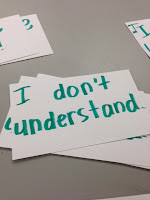Phonemic awareness, or the ability to recognize and manipulate
phonemes (individual sounds in a language) is one of the most vital components to early literacy skills. Being able to recognize that sounds are related to symbols, characters, or letters and eventually words (phonics) leads to strong readers.
METALINGUISITC AWARENESS
Just as
metacognition ("thinking about thinking" or "knowing about knowing") is a general educational practice for all grades,
metalinguistic awareness (the ability to objectify a language - or understand when you are speaking one or an other) needs to be highlighted when teaching ESL students literacy.
Since young children are learning to read and write and their metacognition and metalinguistic awareness are still being developed, explicit instruction of phonemic awareness (in preferably BOTH languages) helps students realize that they speak two languages.
Imagine if you were a young ESL-er riding on two sets of train tracks that take you to the same place; The train tracks represent language (the means/way of understanding a message) and the place represents the meaning or message of the communication act (the point of saying something). Since you don't know how to read and write yet, you don't SEE that you are riding on different tracks, but you can HEAR it.
PHONEMIC AWARENESS PRACTICE IN ESL
This is why phonemic awareness is so important. Not only does it build literacy skills but it help differentiate the sounds between languages, which ultimately leads to the understanding of one's own bi- or multilingualism (metalinguistic awareness)!
A way I introduce metalinguistic awareness is that I tell my students, "You know you speak more than one language because you understand what your family says to you at home, and when you come to school, you understand what I tell you! Even though the sounds your family makes and the sounds I make are different, you still know what I'm saying!" (Despite metalinguistic awareness NOT being part of the general curriculum, it is incredibly important to language development and needs to be taught in ESL classrooms.)
Young ESL children are absolutely NOT the on the same playing field as native English speakers in regards to literacy. Their brains are competing to build a working system of understanding between two sets of sounds - or two languages. Phonemic awareness in both languages builds a foundation of bi-literacy. One great strategy to focus on phonemic awareness is using phones!

The phones are simply made plastic tubes with a curve. Students hold the phones up to their ear and mouth and speak into them so they can hear their own voices and they sounds they make. These are great for rote speaking practices, repeating, and daily routines where speaking is involved. Other teachers use them in areas when children hold the phones while reading a list of letters and sight words out loud. I've even witness some of my children exit their silent period with the use of these phones. They love speaking into them and hearing the sounds they make - give it a try! You'll definitely see some light bulbs on you bright, shining students!
On a budget? Head to the local hardware store and pick up some elbow PVC piping. Works like magic (for less)!






























